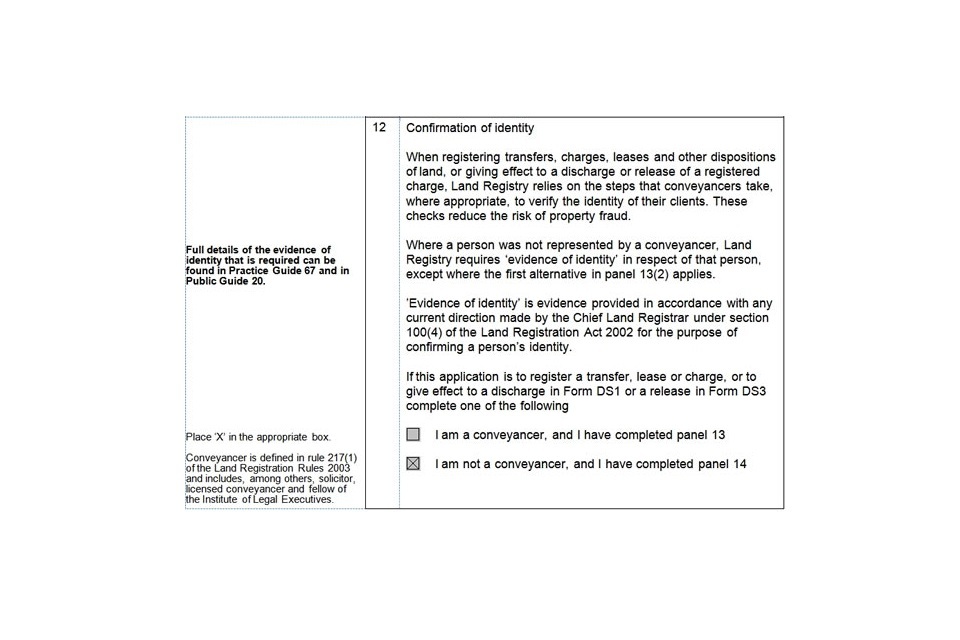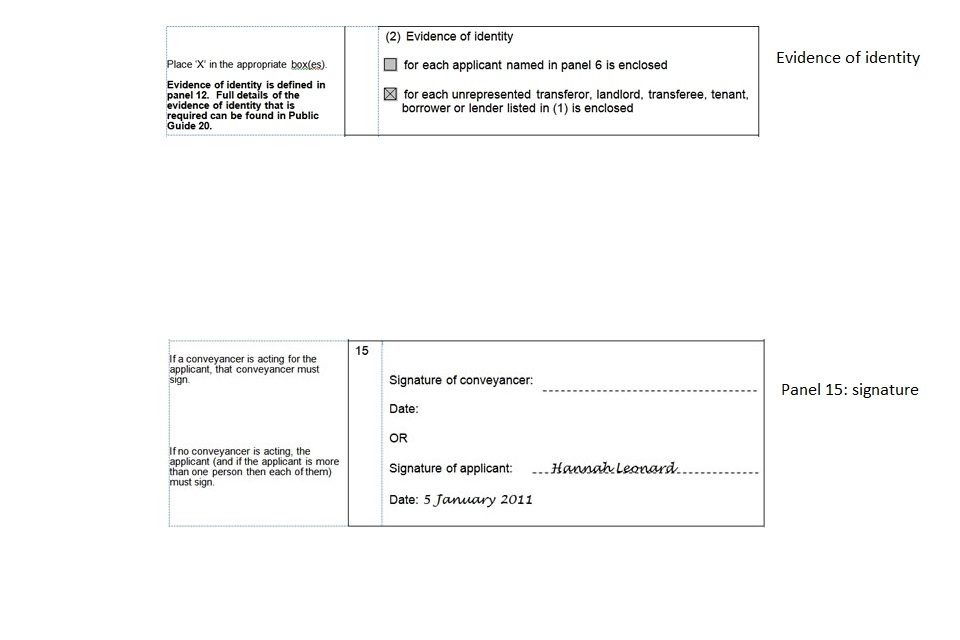Completing the evidence of identity panels on forms AP1, FR1, DS2
Forms AP1, FR1 and DS2: guidance on when evidence of identity must be lodged in support of an application for registration.
Applies to England and Wales
Introduction
Land and buildings are usually the most valuable assets people own. They can be sold and mortgaged to raise money and can therefore be attractive targets for fraudsters.
HM Land Registry, professional conveyancers and mortgage lenders all have safeguards to minimise the risk of a fraud being successful and this includes checking the identity of clients and parties involved in transactions affecting property.
HM Land Registry also needs to check the identity of parties involved in some types of property transactions where a conveyancer is not acting, to make sure that the application is not fraudulent.
Fraud notice
If, when there is a requirement to confirm identity or provide evidence of identity, you dishonestly provide information or make a statement that you know is, or might be, untrue or misleading, and intend by doing so to make a gain for yourself or another person, or to cause loss or the risk of loss to another person, you may commit the offence of fraud under section 1 of the Fraud Act 2006, the maximum penalty for which is 10 years’ imprisonment or an unlimited fine, or both.
Application process
If you are sending or bringing an application to us, please make sure you have all the right documents and evidence required for your type of application and everything has been completed correctly. You will then need to complete the application form required for your type of application and have the identity of any unrepresented person verified, where this is necessary.
- You must provide confirmation of identity for any of the parties or persons mentioned in Confirmation of identity requirements by completing the relevant panels in application form AP1, form DS2 or form FR1.
- If any of the parties mentioned in the table are not legally represented, you will also need to provide evidence of identity.
- if the application is being sent to HM Land Registry by someone who is not one of the parties or persons mentioned in the table, you will need to provide evidence of their identity
Deeds and documents sent to us with applications will be scanned and then destroyed whether they are originals or copies.
If you want to keep the original of a document you should not send it to us. Instead you should make a photocopy and then certify that this is a true copy of the original. This is done by simply writing “I certify that this is a true copy of the original” and signing at the top of page 1. You can send us a copy of an ID form but the person completing part B of forms ID1 and ID2 will still need to sign and date the photograph on the back and your certified copy will need to copy both sides of the photograph.
There is one exception. If your house is not registered, then you need to send any original documents in your possession, which we will return.
Confirmation of identity requirements
| Application | Person for whom confirmation of identity is required |
|---|---|
| Transfer of land or transfer of a mortgage (whether or not for money, also includes transfers to appoint or remove a trustee and assents by personal representatives | Transferor (seller), Transferee (buyer), any attorney acting for the seller or buyer, any personal representative |
| Lease (whether or not for money) | Landlord, Tenant, any attorney acting for the landlord or tenant |
| Surrender of a registered lease: application to close the leasehold title (includes surrenders by transfer and by operation of law) | Landlord, Tenant, any attorney acting for the landlord or tenant |
| Mortgage (charge): of registered land or of unregistered land on compulsory first registration | Lender (chargee), Borrower (chargor), any attorney acting for the lender or borrower |
| Discharge of mortgage in paper form DS1 or form DS3 | Lender |
| Compulsory first registration explains when an application for first registration is compulsory) | Seller or landlord, Buyer or tenant, any attorney acting for the above |
| Voluntary first registration but only where the deeds have been lost and the applicant is not a conveyancer or a well-known corporate body who lost them themselves | Applicant for first registration as proprietor of the land, including where the applicant is a personal representative, any attorney for the applicant |
| Change of name by deed poll, statutory declaration or statement of truth | Person changing their name (in their new name) |
| Change of address |
Exceptions
There are some exceptions, which are set out in full in practice guide 67: evidence of identity. The main exceptions affecting applications sent by non-conveyancers where we do not need confirmation of identity for some or all parties are:
- a lease or a charge which is merely being noted in the register
- voluntary applications for first registration unless the title deeds have been lost or destroyed.
We also do not require confirmation of identity for certain parties who already have to send us evidence of their appointment. This includes trustees in bankruptcy, liquidators and Mental Health Act deputies (a full list is in practice guide 67: evidence of identity). This exemption applies both when they are parties to a deed, and when they are also sending the affected application to us themselves.
Please note though that confirmation of identity is still required for the beneficiary under an assent or the transferee under a transfer, and also for any person lodging the application (unless they are the trustee in bankruptcy etc as referred to in the above paragraph). This applies both in situations where the land is already registered and also where an application is being made for compulsory first registration. In addition to the above we also do not require confirmation of identity where the true value of the land involved in the disposal does not exceed £6,000.
Confirmation of identity panels on applications by non-conveyancers
Form AP1
Panel 12: Confirmation of identity
You must complete the second option and then go to panel 14.

How to complete Panel 12
Panel 14: Where the application is sent to HM Land Registry by someone who is not a conveyancer
(1) Details of conveyancer acting
If your application is one of those mentioned in the first column in the table in section 2 above, you must then complete the first part of panel 14 with the full names of the parties or persons referred to in the table you are sending to us, and state the details of any conveyancer who acted for them. If any of the parties are not legally represented write ‘None’ in the second column.
The following is an example of how to complete this panel.

How to complete Panel 14
The second part of this panel only needs to be completed in cases where a discharge or release of a mortgage in paper form DS1 or form DS3 is being lodged with the application. Completion is similar to the first part above.
(2) Evidence of identity
You must always complete this section. For information about this, please also see ‘Completing forms ID1 and ID2’ and ‘Completing form ID3’.
You only need to cross the first box (‘for each applicant named in panel 6 is enclosed’) if the applicant shown in panel 6 of your form is different to any of the persons named in panel 14.
You must cross the second box (‘for each unrepresented transferor, etc’) if you have written ‘None’ in the second column in any of the above panels.
In the above example we need evidence of identity of Hannah Leonard because she is not legally represented. If someone other than her sends the application to us, we will also need evidence of identity for them if they are not a conveyancer.

How to complete Evidence of identity and signature
Panel 15: Signature
You must always complete this panel, even if you are not completing panel 14. Every person listed in panel 6 as applicant must sign. It is not sufficient for the person named in panel 7 (if different) to sign.
Form FR1
Panels 14, 16 and 17
Completion is essentially the same as with form AP1. There is no separate discharge panel because there will be no registered charge to discharge.
You do not have to complete panels 14 and 16 if you are applying for voluntary first registration.
You must always complete panel 17, even if you are not completing panel 14. Every person listed in panel 6 as applicant must sign.
Form DS2
Panel 8: Confirmation of Identity
You must complete the second option.
Panel 10: Where the application is sent to HM Land Registry by someone who is not a conveyancer
Completion is essentially the same as in form AP1, with the exception that there is only a lender’s panel to complete. Where no conveyancer is acting for either party, we require evidence of identity for the lender and the applicant (except where the applicant is a UK bank or building society in respect of their own charge). However, if form DS1 or form DS3 has been signed by an attorney for the lender (or by other authorised signatory), we do not require confirmation of identity for the attorney/agent.
Panel 11: Signature
You must always complete this panel.
Properties where the true value does not exceed £6,000
You do not have to confirm the identity of persons involved in transactions where the true value of the land which is the subject of the disposal does not exceed £6,000. In these cases you may instead lodge a certificate by someone qualified to give property valuations confirming the value of the land, for example an estate agent, a surveyor, a land and property valuer or auctioneer who holds a qualification from the Royal Institution of Chartered Surveyors or some other person who is similarly qualified.
You may still supply evidence of identity if you prefer, and we also reserve the right to require evidence of identity in form ID1 or form ID2, in any particular instance.
Facility letter arrangements
HM Land Registry has issued ‘facility letters’ for a limited number of people who regularly deal with HM Land Registry. These exempt these individuals from our normal identity requirements. A copy of the facility letter must be enclosed with any application where confirmation of identity is usually required, in place of form ID1 or form ID2.
A facility letter can only be used where the value of the property does not exceed £100,000.
If you wish to apply for such an arrangement please contact customer support.
If you require further support
HM Land Registry is committed to ensuring accessibility for all of our customers. If because of your condition or circumstances you require further support, you should [contact us]([https://www.gov.uk/guidance/contact-hm-land-registry].
Send your forms
Send the completed form(s) to our Citizen Centre, see HM Land Registry address for applications.
Updates to this page
-
Following a review of our practice, a personal representative who assents or transfers land has been removed from the exception status and must now provide evidence of identity with any such application.
-
Amended to reflect our current identity policy which is contained in practice guide 67.
-
Clarified the guidance for form DS2 where no conveyancer is acting for either party. We require evidence of identity for the lender and the applicant (except where the applicant is a UK bank or building society in respect of their own charge).
-
First published.